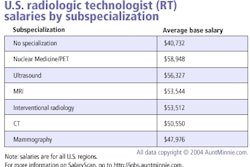SAN FRANCISCO - When members of the Medical Group Management Association's (MGMA) Radiology Assembly gathered to chat on Monday, they began the meeting with a healthy dose of navel-gazing: Specifically, they asked, should their subsection of the MGMA even continue to exist?
After all, the radiology subgroup is not among the association's strongest, with just 619 members, compared to the 1,181 members in the cardiovascular subgroup and 1,147 in the orthopedics assembly.
As for providing information specific to radiology practice management, the MGMA finds itself competing with entities like the Radiology Business Management Association (RBMA), and the American Healthcare Radiology Administrators (AHRA).
But beyond the practical considerations loomed an even larger philosophical question: Do radiology practices still fit within larger healthcare associations like MGMA, when the other members have interests that are increasingly at odds with radiology?
Not that turf wars are anything new. But the issue of in-office ancillary imaging essentially pits radiology against every other medical specialty, at a time when self-referral is growing to epic proportions, according to the subsection in question.
"I think our big competition is from the referring physicians," said one radiology practice executive at yet another open-forum meeting this week in San Francisco (this one sponsored by the RBMA, which invited members who would be in town for the MGMA.)
Unlike the American Medical Association -- which has vowed to oppose attempts to repeal in-office ancillary-service exceptions in state and federal laws -- MGMA hasn't stepped out officially as radiology's opponent on the self-referral issue.
But it seems clear, based on the association's demographics, where its sympathies would have to lie.
The MGMA Web site does feature several articles on nonradiology specialty groups enhancing their revenues with imaging services. The association's latest annual survey of cardiology practices also found a 19% increase in the number of responding groups that offered office-based nuclear imaging over the prior year.
Faced with many similar stats and anecdotes, it was no surprise that self-referral was a dominant topic of conversation among the radiology practice executives at the assembly. Attendees seemed to agree that health insurers might be the ones to really combat self-referral, through their ability to impose quality criteria on imaging providers.
In contrast, the appearance of self-interest might hamper any direct battles waged by imaging specialists, who also bear some blame for the burgeoning popularity of self-referred imaging.
"Radiologists failed by not fighting for a reasonable professional component (in reimbursement for services)," said John Relic, moderator of the Radiology Assembly roundtable.
"The money is all in the technical component, and now radiologists have got 'entitlement disease,'" added Relic, who is also a radiology business consultant and president of BCS Service of Austin, TX.
As to how imaging specialists might strengthen their hand within the MGMA, Relic agreed to approach radiology's traditional allies in hospital-based medicine, the anesthesiologists and pathologists, about a combined RAP assembly.
Other meeting attendees pressed the idea of collaborating more with the RBMA, especially in surveys that can generate much-sought benchmarking data.
Many others said they would continue their membership with MGMA, both for the general information on practice management, and for insight into their customer-competitor communities.
As noted by Darlene Zase, executive director of Advanced Radiology Consultants in Trumbull, CT: "It's great for people who manage radiology practices to come to MGMA to see what's going on with the referring practices."
By Tracie L. Thompson
AuntMinnie.com staff writer
October 7, 2004
Related Reading
Stark II interim final rule leaves huge self-referral loophole, July 20, 2004
The impact of phase II Stark regulations on freestanding imaging centers, May 13, 2004
ACR reverses course on ortho MRI, May 11, 2004
NCQDIS launches overutilization awareness campaign, April 29, 2004
Non-radiologists outpace radiologists in skyrocketing use of ultrasound, December 1, 2003
Copyright © 2004 AuntMinnie.com



















